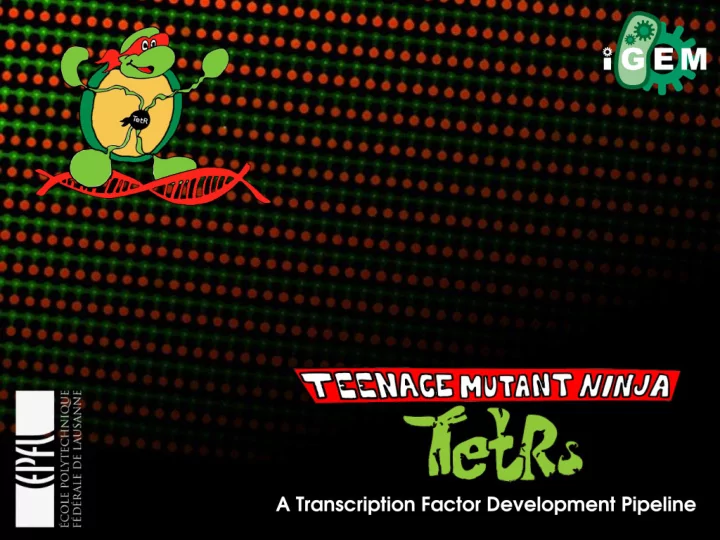

Want a more interesting circuit? Elowitz et al ., Nature (2000).
? lacI tetR cI ? ?
Introducing… Our Transcription Factor Development Pipeline:
Select mutants Using Lysis
The idea: release DNA of valid mutants.
Implementation: BL21 cells have IPTG-inducible T7 RNA Polymerase Lysis cassette from Berkeley 2008: BBa_K112808
To prove it can work, we need to: 1) Control lysis 2) Recover DNA 3) Select the right DNA
Control Lysis Recover DNA Select the right DNA IPTG addition 0 µM IPTG 1000 µM IPTG
Control Lysis Transformation Recover DNA Lysis Select the right DNA Control qPCR Lysis Lysis Control Control
Control Lysis Recover DNA Transformation Select the right DNA RFP GFP qPCR RFP Lysing (RFP) and control (GFP) cells GFP
Select mutants Using Lysis
Characterise in vitro using microfluidics
Tetracyclin Repressor WT TetO sequence:
We mutate the sites of DNA interaction WT E37A W43S T141A V36F P39K Ramos et al. (2005), Orth et al. (2000), Helbl et al
In vitro TF characterization • 768 TF-DNA interaction measurements in 5h • High sensitivity • Absolute affinities 38000 datapoints collected Maerkl et al ., 2007 this summer
enoLOGO: Workman et al , 2005
Characterise in vitro using microfluidics
Characterise in vivo using reporter genes
In vivo readout principle Weak interaction? Strong interaction? No Interaction? …detect and quantify TetR binding to its promoter
Readout implementation TetR represses RFP: Adding ATC cancels repression:
Wild-type characterisation Maximum ATC: 25’000 RFUs No ATC: 2500 RFUs
The mutants repress RFP differently: E37A W43S T141A
Consistency of the two characterisations: TetR Mutant In vitro specificity In vivo activity Strong activity Same as WT E37A W43S Same as WT T141A No activity
Characterise in vivo using reporter genes
Using the right tools helps.
Microfluidic systems are gaining popularity within iGEM: Alberta 2009 Biotec Dresden 2009 Strasbourg 2010 MIT 2010 Maybe your successors will give it a go?
Thankfully, you can order from a foundry, such as Stanford’s .
In summary, we: Set up a lysis-based selection system Developed characterisation methods • MITOMI chip for binding specificities • RFP-based in vivo system Demonstrated them with TetR mutants Promoted microfluidics to the iGEM community
Huge thanks to: Our teaching assistants: Our professors: Bart Deplancke Sebastian Maerkl Laboratory for Systems Biology and Genetics Alina Henrike Laboratory for Biological Network Characterization The artist: Fundraising: Irina Matt Sacha Sidjanski Solange &Caroline O’Neill Richter
Questions?
Recommend
More recommend